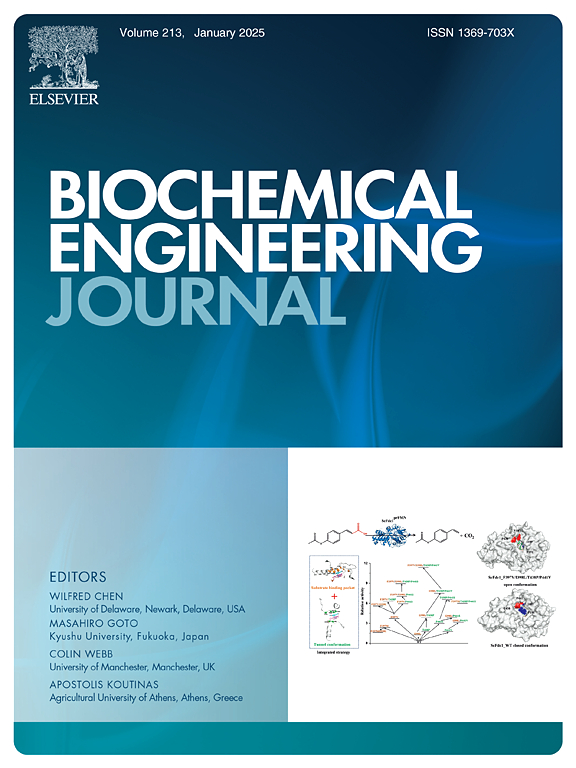Maximizing harvesting of Chlorella vulgaris via calcium oxide nanoparticle-modified fungal pellet using response surface methodology
IF 3.7
3区 生物学
Q2 BIOTECHNOLOGY & APPLIED MICROBIOLOGY
引用次数: 0
Abstract
This study aims to optimize the harvesting of Chlorella vulgaris using calcium oxide nanoparticle modified-Aspergillus pseudonomiae pellets (AP@CaONP). To maximize harvesting efficiency, response surface methodology (RSM-CCD) was applied to statistically optimize key parameters, including mycelial dosage (%), agitation speed (rpm), and pH. Lipid yield from harvested C. vulgaris biomass under optimized conditions was analyzed, and resulting fatty acid methyl esters were identified using Gas Chromatography-Mass Spectrometry (GC-MS). Additionally, the recycling potential of spent medium for recultivation of C. vulgaris was evaluated. Scanning Field Emission Scanning Electron Microscopy (FESEM), Fourier Transform Infrared spectroscopy (FTIR), and zeta potential analyses were conducted to confirm the interaction between AP@CaONP and C. vulgaris. The results show that under optimized conditions (6 % mycelial dosage, 170 rpm, pH 5.5), harvesting efficiency reached 99.24 % in 60 minutes with only a 0.2 % deviation between predicted and experimental values. Lipid yield from harvested biomass reached 26.98 %, and GC-MS revealed fatty acids including C16:0, C16:1, C16:2, C18:0, C18:1, and C18:2. C. vulgaris showed similar growth patterns in fresh and recycled BG-11 media, indicating minimal impact on biomass productivity and reduced water consumption. This optimized AP@CaONP-based harvesting method offers a practical, eco-friendly approach for efficient microalgae biomass recovery, supporting sustainable biodiesel production from Chlorella species.
利用响应面法通过氧化钙纳米颗粒修饰真菌颗粒最大化地收获普通小球藻
本研究旨在优化利用氧化钙纳米颗粒修饰伪曲霉微球(AP@CaONP)收获普通小球藻的工艺。为了最大限度地提高收获效率,采用响应面法(RSM-CCD)对菌丝用量(%)、搅拌速度(rpm)和ph等关键参数进行了统计优化。分析了优化条件下收获的寻常草生物量的脂质产率,并利用气相色谱-质谱(GC-MS)对所得脂肪酸甲酯进行了鉴定。此外,还对废培养基的再培养潜力进行了评价。通过扫描场发射扫描电镜(FESEM)、傅里叶变换红外光谱(FTIR)和zeta电位分析证实了AP@CaONP与C. vulgaris之间的相互作用。结果表明,在优化条件下(6 %菌丝投加量,170 rpm, pH 5.5), 60 min收获效率达到99.24 %,预测值与实验值相差0.2 %。所得生物质的脂质产率达到26.98 %,GC-MS检测到的脂肪酸包括C16:0、C16:1、C16:2、C18:0、C18:1和C18:2。在新鲜和回收的BG-11培养基中,寻常草的生长模式相似,表明对生物量生产力的影响最小,耗水量减少。这种优化的AP@CaONP-based收集方法为有效回收微藻生物量提供了一种实用、环保的方法,支持小球藻物种可持续生产生物柴油。
本文章由计算机程序翻译,如有差异,请以英文原文为准。
求助全文
约1分钟内获得全文
求助全文
来源期刊

Biochemical Engineering Journal
工程技术-工程:化工
CiteScore
7.10
自引率
5.10%
发文量
380
审稿时长
34 days
期刊介绍:
The Biochemical Engineering Journal aims to promote progress in the crucial chemical engineering aspects of the development of biological processes associated with everything from raw materials preparation to product recovery relevant to industries as diverse as medical/healthcare, industrial biotechnology, and environmental biotechnology.
The Journal welcomes full length original research papers, short communications, and review papers* in the following research fields:
Biocatalysis (enzyme or microbial) and biotransformations, including immobilized biocatalyst preparation and kinetics
Biosensors and Biodevices including biofabrication and novel fuel cell development
Bioseparations including scale-up and protein refolding/renaturation
Environmental Bioengineering including bioconversion, bioremediation, and microbial fuel cells
Bioreactor Systems including characterization, optimization and scale-up
Bioresources and Biorefinery Engineering including biomass conversion, biofuels, bioenergy, and optimization
Industrial Biotechnology including specialty chemicals, platform chemicals and neutraceuticals
Biomaterials and Tissue Engineering including bioartificial organs, cell encapsulation, and controlled release
Cell Culture Engineering (plant, animal or insect cells) including viral vectors, monoclonal antibodies, recombinant proteins, vaccines, and secondary metabolites
Cell Therapies and Stem Cells including pluripotent, mesenchymal and hematopoietic stem cells; immunotherapies; tissue-specific differentiation; and cryopreservation
Metabolic Engineering, Systems and Synthetic Biology including OMICS, bioinformatics, in silico biology, and metabolic flux analysis
Protein Engineering including enzyme engineering and directed evolution.
 求助内容:
求助内容: 应助结果提醒方式:
应助结果提醒方式:


